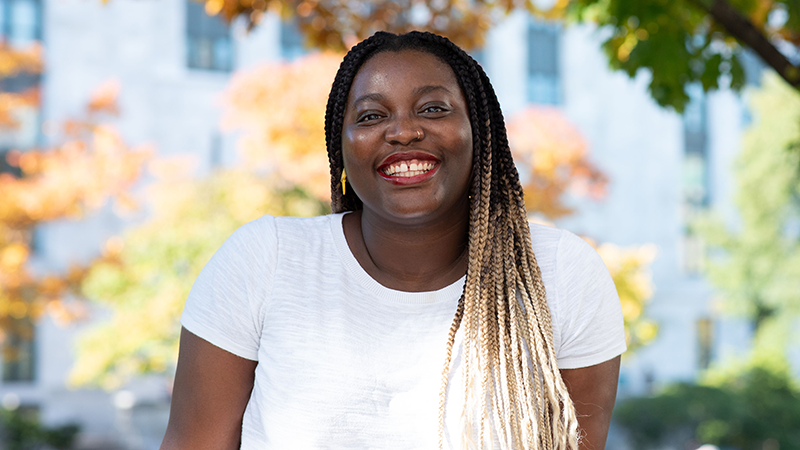I study how the ear gets wired to receive sound information from the environment. During development, many different cells need to get to the right place and make stereotyped connections in a precise manner for us to be able to hear. My research examines how two of these cell types, neurons and glia, interact in wiring the cochlea, the organ of hearing. Understanding how cochlea wiring is established during development will provide useful insight for therapies to treat or prevent hearing loss.
Photo by Celia Muto
What career did you aspire to as a child?
I grew up in Lagos, Nigeria. In my country, children decide at age twelve what career path to go into and must choose one of three disciplines – the sciences, the arts or the social sciences – to take courses in. I excelled at science, so I was strongly encouraged to pursue a career in medicine. I made a bargain at senior secondary school (equivalent to high school in America) to be able to take Literature and French in addition to my science coursework. Literature drew me to the art of storytelling. So, when my mother asked me many years ago what I wanted to be when I grew up, I said I wanted to be a writer. My mother, like all well-meaning Nigerian mothers, instead replied, “How about you become a doctor first and then you can write about being a doctor?”
Through Education USA, an international student advising network that had a center in Lagos, I learned about liberal arts colleges in the US where I could take courses in every discipline. I left the most prestigious medical school in my country to attend a small liberal arts college in Ohio, Kenyon College. Now, I’m a scientist because writing comes with the job, and my mother is more than okay with it!
What is the first experiment you remember doing?
At Kenyon, the Introductory Biology course had a lab sequence that terminated with an independent research project. I remember my jaw dropping to the floor when my professor, Dr. Jennifer McMahon, clarified that we could design our own experiments from scratch. I was inspired by a line in the textbook on regeneration in C. elegans, so I designed an experiment to study the influence of magnetic fields on C. elegans regeneration. I collaborated with Dr. Klopcic in the Physics department to build magnets for my experimental setup. I also read literature to develop a scoring rubric and it felt fabulous to contribute to and participate in the broader scientific community. This was my first experience of a curiosity-driven experiment and I come back to this memory when I start to feel discouraged in my work.
What is the hardest part about the work you do?
I am very vocal about my experience living with post-traumatic stress disorder. Thankfully, I have access to treatment, but it can be very debilitating. As a Black woman, I’m acutely aware of my intersectionality in science. I continue to make strides each day in science despite my PTSD, but there are many people who share one or more of my identities, and are not able to access the opportunities I have had. Maybe it bothers me so much because I am a firstborn daughter and was raised according to my mother’s culture, but it is not enough for me to just DO science. It is hard walking the path of the first- or only-person in rooms. I’m thankful for the space organizations like USN and BlackInNeuro provide, and the opportunities I’ve had to serve on the Student Mental Health Committee. I can only be successful when more people like me are equipped and able to pursue their dreams in science.
Who or what most inspires you and why?
I am most inspired by my family. They are brave, strong people who can laugh at themselves despite all the challenges they face. My Kenyon professors are also another huge source of inspiration to me. They showed a young, Black, African woman, that she could dare to debunk textbook knowledge and dare to become a professor at a liberal arts college like Kenyon one day.


